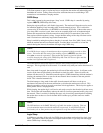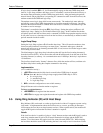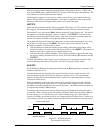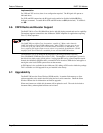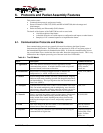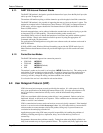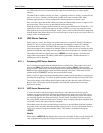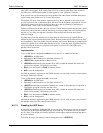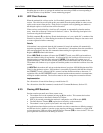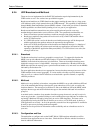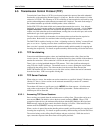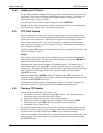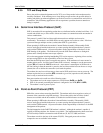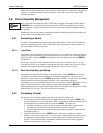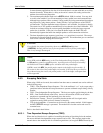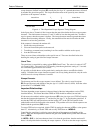
User’s Guide Protocols and Packet Assembly Features
2110212 Rev 1.0 Page 41
Disabling the server does not prevent the modem from answering a PING or from responding to
the Sierra Wireless GroupWatcher
™
remote monitoring program.
6.2.2. UDP Client Features
When the modem dials a client session, it will randomly generate a source port number for the
session. The called server will pick up this port number from the packet header in order to route
replies to the correct client process. Each session is assigned a new originating port number so
that delayed replies to closed sessions will be discarded.
Client sessions can be dialed by a local host AT command, or automatically when the modem
starts. Auto-dial on Start-up is discussed in Section 5.3 above. The following description is for
local hosts using the dial command.
The Dial command (D) can dial any IP and destination port, or it can “quick dial” a member of the
Friends List (Section 5.1). When dialing, the modem can immediately change to data state or wait
to ensure registration before connecting.
Details
If the modem is not registered when the dial command is issued, the modem will automatically
begin the registration process. Since UDP is “connectionless”, the modem allows the transition to
data state immediately after the dial command without waiting for registration to complete.
Register +WS179 controls this feature.
When +WS179=0, the modem will return the CONNECT result, assert DCD, and transition to
data state without waiting for registration. If registration fails, the local host will have no way of
knowing unless it escapes data state and queries +WS56. The modem will continue to try to
register indefinitely. The local host can send packets to the modem buffers and close the session.
The modem will continue to try to register and send the packets even after the local host closes the
session.
If +WS179=1, the modem will wait up to the duration set in register +WS198 (Registration Wait
Time) for the modem to register. If the modem is successfully registered within the time allowed,
the CONNECT result is returned, DCD is asserted, and the modem transitions to data state. If
registration fails, the NO CARRIER result is returned and the modem remains in command state,
waiting for another command. The local host must be able to manage these connection failures.
Implementation
For a discussion of Auto-dial on Start-up, consult Section 5.3.
For a discussion of the Dial command, consult the AT Command Reference, Section 12.2.
6.2.3. Closing UDP Sessions
Sessions remain open until one of these events occur:
• The modem receives the command to hang-up (H) the session. This assumes the host has
escaped data state as described in Section 6.6.3 below.
• DTR is de-asserted, presuming the modem is configured to use DTR for this (&D2).
• The PAD Session Timeout (S30) expires due to inactivity on the connection.
• The modem is reset or power-cycled (and is not using auto-dial).
For applications where distinct sessions are desirable (exclusive connections to differing remotes)
and the host device is unable to issue the escape sequence and hang-up command, or toggle DTR
to close the session, UDP can still use the PAD Session Timeout (S30) to close sessions. This can
place significant restrictions on the timing of sessions.



